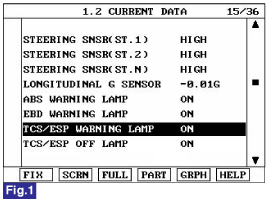Monitor the "ESP SWITCH" parameter on the scantool.
Specification : It is changed to ON/OFF.

Fig 1) Test Condition : Ignition "ON" & Engine "OFF"
Normal Data
Driver can inhibit the ESP control by ESP switch.
When switch signal send into HECU, ESP warning lamp go ON and ESP control is stopped and if next switch signal is inputted again, ESP control is ready. This function is used for sporty driving or vehicle inspection.
Trouble code is set when the condition that the level of ESP switch is high is continued for 60sec.
When the ESP switch failure is set, Warning lamps won't illuminate and HECU allow the ABS/EBD/ESP control.
Item | Detecting Condition | Possible cause |
DTC Strategy | ● Circuit Monitoring | ● Open or short ESP switch circuit ● Faulty ESP switch |
Enable Conditions | ● When the ESP switch is ON for 1 minute. | |
Fail Safe | ● Inhibit the ESP control and allow the ABS/EBD control. ● The ESP warning lamp is activated. |
Engine ON | ESP switch HIGH | ESP switch LOW |
7.0V ~ 16.0V | 0V ~ 3.0V |

Connect scantool to Data Link Connector(DLC)
Ignition "ON" & Engine "OFF".
Press the ESP SWITCH.
Monitor the "ESP SWITCH" parameter on the scantool.
Specification : It is changed to ON/OFF.

Fig 1) Test Condition : Ignition "ON" & Engine "OFF"
Normal Data
Whenever the switch is pushed up/down, is the esp off switch's scantool data changed ON/OFF?
 | ▶ Fault is intermittent caused by poor connection in ESP switch harness and/or HECU's connector or was repaired and HECU memory was not cleared. Thoroughly check connectors for looseness, poor connection, bending, corrosion, contamination, deterioration, or damage. Repair or replace as necessary and then go to "Verification of Vehicle Repair" procedure. |
 | ▶ Go to "Terminal and Connector Inspection" procedure. |
Many malfunctions in the electrical system are caused by poor harness(es) and terminal condition. Faults can also be caused by interference from other electrical systems, and mechanical or chemical damage.
Thoroughly check connectors for looseness, poor connection, bending, corrosion, contamination, deterioration, or damage.
Has a problem been found?
 | ▶ Repair as necessary and then go to "Verification of Vehicle Repair" procedure. |
 | ▶ Go to "Signal Circuit Inspection" procedure. |
Ignition "ON" & Engine "OFF".
Press the ESP SWITCH.
Measure voltage between ESP switch signal terminal of the HECU harness connector and chassis ground.
Specification : Approx B+
Is the measured value within specifications?
 | ▶ Go to "Component Inspection" Procedure. |
 | ▶ Check for open or blown 10A fuse referring to "Circuit Diagram". Repair open or short in power circuit between battery and HECU harness connector and then, go to "Verification of vehicle Repair" procedure. If there is no problem in circuit, Go to "Component Inspection" procedure. |
Ignition "OFF" & Engine "OFF".
Disconnect the ESP switch connector.
Measure resistance between power terminal and siganl terminal of the ESP switch connector.
Specification : Approx. below 1Ω (In case of pressing the ESP switch)
Approx. ∞ Ω (In case of not pressing the ESP switch)
Is the measured value within specifications?
 | ▶ Fault is intermittent caused by poor connection in ESP switch harness and/or HECU's connector. Go to "Verification of Vehicle Repair" procedure. |
 | ▶ Substitute with a known-good ESP switch and check for proper operation. If problem is corrected, replace ESP switch and then go to "Verification of Vehicle Repair" procedure. |
After a repair, it is essential to verify that the fault has been corrected.
Connect scantool and select "Diagnostic Trouble Codes(DTCs)" mode
Using a scantool, Clear DTC.
Operate the vehicle within DTC Detecting Condition in General Information.
Using a scantool, Check DTC present.
Are any DTCs present ?
 | ▶ Go to the applicable troubleshooting procedure. |
 | ▶ System performing to specification at this time. |